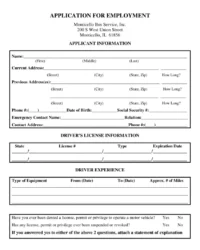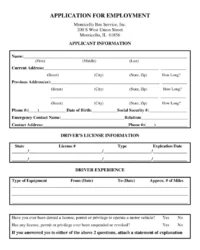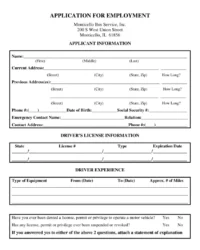Utilizing a pre-designed structure offers several advantages. It streamlines the application process for both drivers and hiring managers, reducing time and effort. Consistency in data collection enables objective comparisons between candidates, promoting fair hiring practices. Furthermore, a well-designed form can help ensure compliance with relevant regulations and reduce the risk of overlooking critical information.
This foundation of efficient information gathering plays a crucial role in the driver recruitment process. The following sections will delve into the specific components of these forms, exploring best practices for completion and utilization, and highlighting how they contribute to a successful hiring outcome.
Key Components of a Commercial Driver Application
Several essential elements comprise a comprehensive application for commercial driving positions. These components provide a structured overview of an applicant’s qualifications, experience, and suitability for the role.
1. Personal Information: This section typically includes full legal name, contact details, and sometimes date of birth. Accurate and up-to-date information is crucial for verification and communication.
2. Commercial Driver’s License Information: Applicants must provide their CDL number, issuing state, endorsements, and any restrictions. This verifies licensure and determines eligibility for specific roles.
3. Driving Experience: A detailed history of previous driving employment, including company names, dates of employment, and types of vehicles operated, is essential. This section often requires information about mileage and accident history.
4. Employment History: A complete record of previous employment, even non-driving roles, demonstrates work ethic and stability. This includes company names, dates of employment, and job titles.
5. Education and Training: Information regarding educational background and any specialized training, such as hazardous materials handling or defensive driving courses, adds value to an application.
6. References: Providing professional references allows potential employers to gain insights into an applicant’s work habits and character from previous supervisors or colleagues.
7. Certifications and Endorsements: Listing additional certifications, like tanker or passenger endorsements, demonstrates specialized skills and broadens employment opportunities.
8. Disclosures and Consent: Applicants typically acknowledge and consent to background checks, drug screenings, and motor vehicle record checks. This ensures transparency and compliance with regulations.
A thorough application offers a comprehensive profile of a candidate’s qualifications, facilitating informed hiring decisions. The detailed information provided in each section enables employers to assess suitability for specific roles and ensures compliance with industry regulations.
How to Create a Commercial Driver Application Template
Developing a standardized application form for commercial driver positions ensures consistency in information gathering and simplifies candidate evaluation. A well-structured template streamlines the hiring process and promotes compliance with relevant regulations. The following steps outline the process of creating such a template.
1. Define Essential Information: Determine the specific data points required from applicants. This includes personal details, licensing information, driving experience, employment history, education, references, certifications, and required disclosures.
2. Structure the Template: Organize the information into logical sections, using clear headings and subheadings. Ensure a user-friendly layout that facilitates easy completion and review.
3. Choose a Format: Select an appropriate format, such as a digital document or a printable form. Consider accessibility and ease of use for both applicants and hiring managers.
4. Craft Clear Instructions: Provide concise and unambiguous instructions for completing each section. Specify required formats for data entry, such as date formats or license number formats.
5. Incorporate Legal Disclosures: Include necessary disclaimers and consent statements for background checks, drug testing, and motor vehicle record reviews. Ensure compliance with relevant regulations and data privacy laws.
6. Review and Refine: Thoroughly review the completed template for accuracy, completeness, and clarity. Seek feedback from relevant stakeholders to ensure its effectiveness and usability.
7. Implement and Maintain: Distribute the finalized template to relevant personnel and establish procedures for its use. Regularly review and update the template to reflect evolving regulations and best practices.
A well-designed template provides a framework for consistent and efficient candidate evaluation. This structured approach facilitates informed decision-making and promotes a streamlined hiring process, benefiting both employers and applicants. Regular review and adaptation ensure the template remains relevant and compliant with industry standards.
Standardized application forms for commercial driver positions offer a crucial tool for efficient and effective recruitment. These structured templates streamline the process of gathering essential information from prospective drivers, ensuring consistency and facilitating objective comparisons between candidates. From personal details and licensing information to driving experience and employment history, a well-designed application captures a comprehensive profile of each applicant. This thorough approach not only simplifies the evaluation process for hiring managers but also promotes compliance with relevant regulations and reduces the risk of overlooking critical information. The structured format benefits applicants as well, providing clear guidance and ensuring a fair and transparent evaluation process.
Ultimately, leveraging a standardized approach to driver applications contributes significantly to the safety and efficiency of the transportation industry. By ensuring a thorough and consistent evaluation process, these templates support the selection of qualified and competent drivers, fostering a more robust and reliable transportation network. Continuous refinement and adaptation of these tools to reflect evolving industry standards and best practices remain essential for maximizing their efficacy and promoting the highest levels of professionalism within the commercial driving sector.


